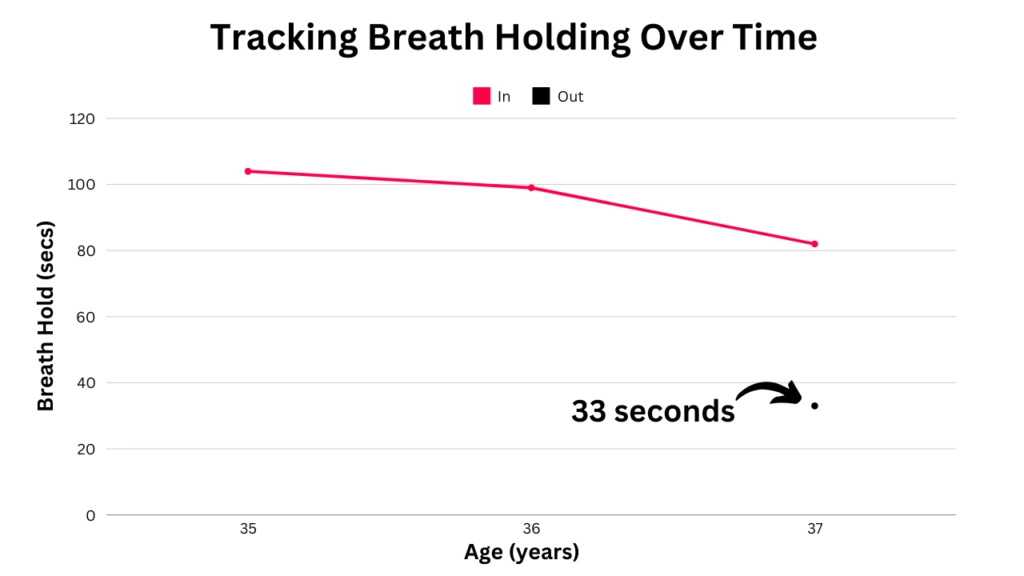At its most basic level, a breath hold can help diagnose a series of conditions known collectively as Chronic Obstructive Pulmonary Disease (COPD). These affect up to 250 million people worldwide, and it takes less than a minute to complete this test.
More broadly, these tests can measure our ability to store and utilise oxygen, lung capacity, and aerobic performance through something called CO2 tolerance.
For safety, these test should never be practised in water or held beyond a minor level of discomfort.
How to Complete a Breath Hold (in)
There are two distinct tests here, holding on the “in” breath, and holding on the “out” breath. Taking a breath in and holding it is the more traditional test associated with breath holding. This is often referred to as the Stange Test.
There are various warm up exercises that can extend the amount of time you are capable of holding your breath. These are not to be done for this test. The breath hold test (BHT) should be done as follows:
- Ensure you are not out of breath before you begin and avoid doing this in the hours after exercise.
- Have a timer ready. This could be a physical stopwatch or one available online.
- Take the test while seated upright.
- Take a deep breath, filling the lungs to around 80% capacity.
- Start the timer.
- Stop the timer when you feel a strong urge to exhale.
- Exhale.

It is a common misconception that your longest breath hold will be achieved by first breathing in as much air as possible. This is also not a test of your mental toughness, and so you are not holding far beyond physical discomfort.
How to Complete a Breath Hold (out)
The second test measures your ability to hold on the “out” breath with empty lungs. This is closer to a physical fitness test and is known as the Genchi Test. It is conducted in a similar way, with one obvious difference (steps 4 and 5):
- Ensure you are not out of breath before you begin and avoid doing this in the hours after exercise.
- Have a timer ready. This could be a physical stopwatch or one available online.
- Take the test while seated upright.
- While breathing naturally, exhale to the point you would normally breathe in.
- Without breathing in again, close your mouth and pinch your nose.
- Start the timer.
- Stop the timer when you feel a strong urge to inhale.
- Inhale.
As with the initial breath test, it is not a test of mental toughness and you should not push yourself beyond physical discomfort. You may be surprised by how much shorter the time period is for this second breath test compared to the first.
What Do My Results Mean?
If you were unable to hold your in breath for 30 seconds that may be an early sign of COPD and should be followed up with a medical professional. Beyond that, the breath holding standards can be seen below.

It is potentially dangerous to resist strong urges to breathe and so the standards are capped at 2 minutes (120 seconds). This is not a test where you are aiming to push yourself to 3 minutes and beyond. If you are trying this at home, please consider stopping at either 90 seconds or 120 seconds, even if you feel capable of continuing. Never attempt this in water.
Being able to hold your breath in for at least 45 seconds indicates good lung function and respiratory efficiency.
Holding on the “out” breath has separate standards for men and women.

If you are untrained, it is quite likely that your result will be classed as “Poor” or “Average”, while those who perform best often have a background in endurance training.
This is measuring your CO2 tolerance, an ability to handle the build up of carbon dioxide in the body. At the same time carbon dioxide rises, your body is also facing a gradual decrease in oxygen levels. It is therefore also assessing your ability to efficiently use the oxygen you have in your system.
Tracking Over Time
Both of these breath hold tests require minimal preparation and are simple enough that they can be completed every year. The breath hold “in” is mainly used to detect COPD, while the breath hold “out” is designed to assess overall cardiorespiratory fitness.

I included the Stange test after turning 35 and only discovered the Genchi test at 37. My initial attempt aged 37 only resulted in an “Average” score of 33 seconds, which means there is room to improve. As this is something that may decline with age, it is sensible for younger individuals to set themselves a higher standard than simply not being “Poor”.
Incorporating cardiovascular exercise alongside techniques like nasal or diaphragmatic breathing is likely to boost your scores in the Genchi Test.

